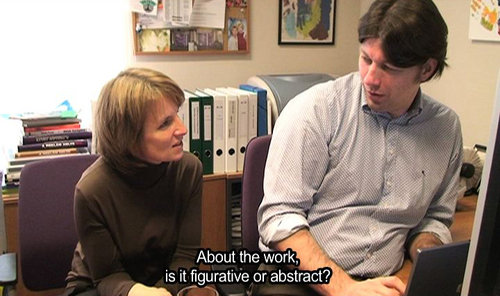Kamen Stoyanov
dal 17/11/2008 al 11/12/2008
Segnalato da
17/11/2008
Kamen Stoyanov
Studio Gallery, Budapest
Forget It, We Can Not Afford This. The artist often deals with the relationship of art and economy and the dynamics of art world. Sensitive to social issues, his creative attitude is coupled with a refined sense of the problematic.

curated by Stepanović Tijana
Having already presented three works at this year's Manifesta - one of
Europe's most significant art biennials -, Kamen Stoyanov often deals with
the relationship of art and economy and the dynamics of art world. Sensitive
to social issues, his creative attitude is coupled with a refined sense of
the problematic, with a strong claim for critical thinking and a markedly
conceptual mindset. No wonder thus that despite his young age, the artist is
already in the limelight of the international art world.
The Bulgarian artist living in Vienna comes out with three new pieces for
his Budapest exhibition, reflecting specifically on the local art market.
The works on show in Studio Gallery explore the positions and relationships
of various - active or passive - actors of Budapest's art scene. The artist
appears in the project as more of an initiator or facilitator than a
creator.
The video work Which one should I buy? models the process that takes place
between collectors and gallerists when a work of art is purchased.
Throughout the experiment two gallerists, Gábor Kozák and Margit Valkó,
compete against each other in making the collectors, Zsolt Somlói and
Katalin Spengler, buy the piece offered by them. The participants, however,
remain incognito to one another, and even the artworks up for sale remain
unseen by the collectors. Communication is conducted through chat, using
only written verbal communication in a dialogue about visual phenomena. But
is a work of art exclusively visual? The collectors' prying questions and
the strategies used by the gallerists tell a lot about the principles
governing the art market. Meanwhile, visuality is successfully - or
unsuccessfully - translated into linguistic structures before our eyes. The
exhibition presents a video documenting the two bargainings and the
encounter/exposure, as well as a "photograph" representing the text of the
chat talks.
The neon piece Forget it, we can not afford this was inspired by an
accidentally overheard fragment of a conversation between a married
collector couple from abroad. Besides being characteristic of the
(Hungarian) art market and the global economic situation, the sentence
receives a highly self-reflexive undertone by being hung on the wall of
Studio Gallery of all places. Stoyanov offers this work for sale, to invest
the returns in saving Labor, a small gallery run by the Studio of Young
Artists. By this gesture he wishes to demonstrate that he considers it
unacceptable that the Hungarian art scene can not afford to maintain this
venue.
The Come and take project explores the attractiveness of contemporary art,
reflecting ironically on the indifferent attitude of the - wider - public.
The irony, however, is aimed not as much at the man of the street who is
less adept at art, as at the actors of the art scene.
Stoyanov handed out 500 flyers around one of the major shopping centres in
Budapest. The first three visitors to show up at the vernissage with the
flyer will get a free copy of the limited edition video work Come and take.
But will the time proven advertising trick succeed in the context of art?
Will it lure new visitors to the exhibition?
The artist, the curator and the Studio of Young Artists cordially invites
all those interested to the opening of the exhibition.
Vernissage: 18 November 2008. (Tuesday) 19
Studio Gallery
H-1077 Budapest, Rottenbiller u. 35.
Opening hours: Tuesday-Friday 16.00-20.00, Saturday 12.00-16.00
Free admission



